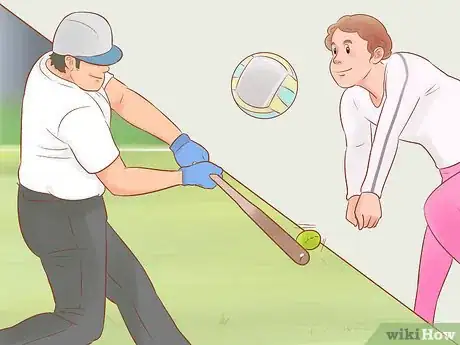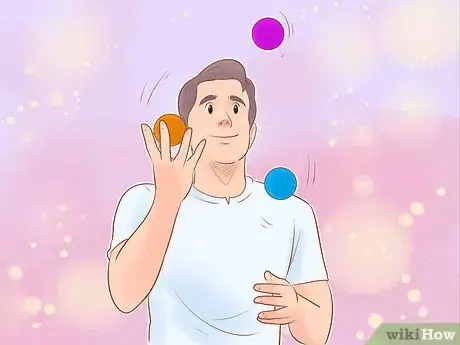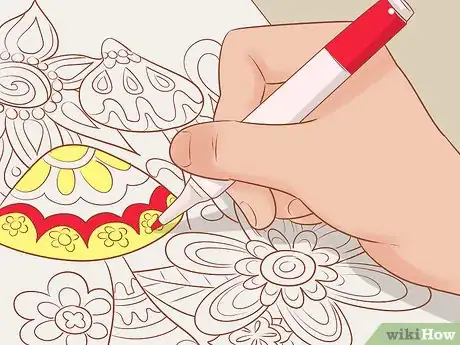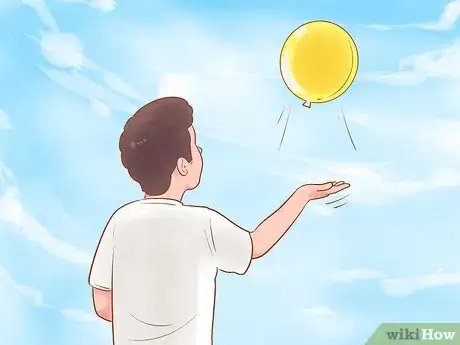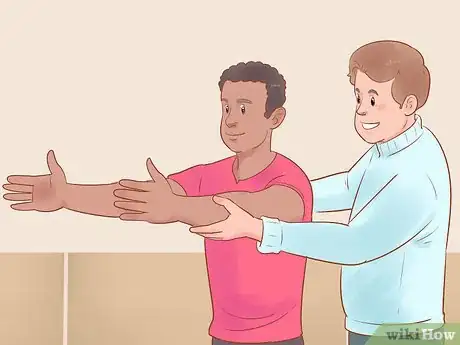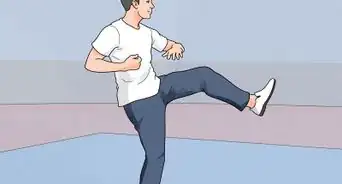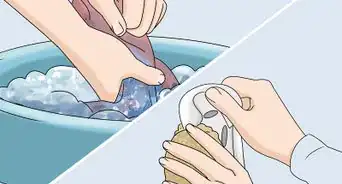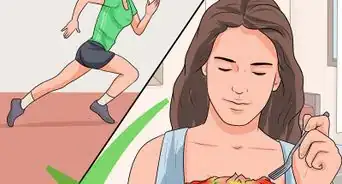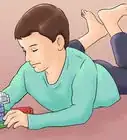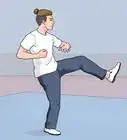This article was co-authored by Peter Fryer. Peter Fryer is a tennis writer and coach based in Derry Northern Ireland. He completed his professional teaching tennis qualification shortly after finishing university and has been teaching tennis for over 13 years. Peter began Love Tennis Blog in 2010 and contributes to the BBC and national media outlets.
There are 10 references cited in this article, which can be found at the bottom of the page.
This article has been viewed 330,062 times.
Improving eye-hand coordination is an ongoing task that tunes many of your fine motor skills.. Children are taught how to improve eye-hand coordination as early as 4 months old through exploring or toys and games. These same principles can be applied at any age through playing sports, video games, coloring, and crafts. You can also use eye-hand coordination training to help manage dyspraxia, a mental condition that makes it hard to plan and coordinate physical movements.
Steps
Improving Coordination with Everyday Activities
-
1Take up a sport as a regular hobby. Almost any sport requires you to coordinate between your eyes and your hands. Pick up a sport that's interesting to you, and make it part of your regular weekly routine. Set a goal of play for an hour 3-4 times a week.[1] Look into intramural teams or classes in your area to help keep your practice consistent and make the process more fun.
- Sports that involve bats or sticks such as baseball, softball, hockey, and lacrosse are all common recommendations for those looking to improve their coordination.
- You could also consider getting a badminton net, volleyball net, basketball hoop, or ping pong table for your home if you want to practice on your own time.
- Boxing and many forms of martial arts are also great to help improve eye-hand coordination. Look into classes in your area for boxing, mixed martial arts (MMA), taekwondo, karate, krav maga, or any other form of martial arts that interests you.
-
2Play video games or online games. Video games require both motor skills and visual perception to execute gameplay. Play a game that requires precision timing, a sensitive touch, and/or great attention to detail, and you may find it helps improve your overall eye-hand coordination. Action games like Call of Duty or Assassin's Creed can be particularly useful for this purpose.[2]
- Try different types of games, if you have the systems available. Console games, PC games, and VR games will all challenge you in different ways.
Advertisement -
3Practice juggling. Learning to juggle is a common activity recommended for people trying to improve their coordination. Start by learning to juggle with 2 balls, then move your way up to three. Consult online tutorials and videos to help get you started, since juggling is often better understood visually.[3]
- Don't get disheartened if you're not a great juggler when you first start. This is an activity that takes a lot of time to master. Keep practicing and you will slowly start to see benefits with your overall hand-eye coordination.
-
4Put together a jigsaw puzzle or building toy. This requires picking up specific pieces to analyze which ones fit together, using and improving both hand-eye coordination and reasoning skills. Challenge yourself even more with a 3D jigsaw puzzle, a Lego sculpture, or another building toy that allows you to think in 3D.[4]
-
5Color in a coloring book. This creative activity helps you learn to visually control your hands and fingers by working in the lines on the page. Look for a coloring book that will challenge you with fine lines and details throughout the page.[5]
- Adult coloring books are gaining popularity, and are readily available at many craft stores and bookstores. Many people find these relaxing as well as a good coordination training tool.
Trying Coordination Drills
-
1Practice switching focus with eye exercises. Try placing 2 similarly-sized objects, such as 2 books, at different distances from one. Place one about 18 inches (46 cm) from you, and the other about 10 feet (3.0 m) away. Focus on the closer object for 5-10 seconds, taking note of as much detail as you can, then quickly switch to the object further away and do the same. Continue this exercise back and forth between your eyes for 3-5 minutes at a time.[6]
- Exercises like this help you improve your reaction time by training you to quickly adjust focus to new subjects.
-
2Do dribbling drills. Dribbling drills like those you find in basketball practice are designed to help build hand-eye coordination. If you're new to dribbling, start by simply walking 10-20 paces in one direction, turning around, and walking back, all while continually dribbling. As you get better, start to vary it by dribbling at different speed and switching back and forth between your hands.[7]
- Challenge yourself by using smaller balls, such as tennis balls. These are more unpredictable when you dribble them, so they challenge your reaction time even more.
-
3Play balloon keep up. This same just requires an oxygen-inflated balloon. Gently toss the balloon up in the air, then follow it around and bump it up before it hits the ground. This game can be played by yourself or with a partner, and is a fantastic exercise in coordination and control.[8]
- Hitting the balloon too hard could send it too far or cause it to pop, so part of the exercise here is to practice applying a controlled amount of force while keeping your eyes on your target.
- This drill can also be a lot of fun for kids who are struggling to build hand-eye coordination.
-
4Try a game of catch while standing on one leg. Catch is often suggested to help build coordination in children, but adults can benefit from a game of catch, too. Instead of just tossing the ball back and forth, though, try standing on one leg while you play. This helps you improve both your balance and reaction time as you build your coordination.[9]
- Play catch with a friend or family member to make the exercise fun and social.
- If you don't have anyone to play with, you can always practice by bouncing your ball off of a nearby wall.
Managing Motor Dyspraxia
-
1Schedule physical activity every day. If you or your child has dyspraxia, physical activity is one of the best things you can do to help build motor skills. Try to set aside at least 30-60 minutes of time for physical activity every day.[10]
- For adults dealing with dyspraxia, going to the gym, going swimming, taking fitness classes, or taking up a non competitive sport such as swimming or dance can all help.
- For children with dyspraxia, signing them up for a sport like taekwondo or soccer, or getting them lessons for activities like swimming and dancing are a good way to set aside some regularly structured time for physical activity.
-
2Practice coordination through play. Simple at-home activities like a game of catch or tossing a bean bag can help a child with dyspraxia build their coordination. Set aside 10-15 minutes each day to play coordination-building games with your kid. Not only will this help them with their hand-eye skills, it also give you some extra quality time together.[11]
-
3Take typing classes. Both children and adults with dyspraxia can have trouble gripping pens and writing clearly. Typing can still pose a challenge, but is often easier than adjusting writing skills. Sign yourself or your child up for a typing class specifically focused on speed-building.[12]
- Ask your child's school of they offer assistive programming in this area. They may be able to set your child up with a typing tutor that specializing in working with motor skills disorders.
-
4See a physical therapist for perceptual motor training. This type of training is designed to help those with dyspraxia improve their movements as well as their visual, hearing, and language skills. Talk to your doctor about finding a physical therapist in your area that offers perceptual motor training.[13]
- This training is based on using sequences of tasks that are challenging, but not so challenging that they inspire the person to quit during the process. Often, these exercises require the participant to integrate different motor and sensory information.
Community Q&A
-
QuestionHow does catching develop eye-hand coordination in learners?
 J.phludCommunity AnswerHand eye coordination is very important in throwing and catching. Practicing catching will activate something in your brain called muscle memory. After you repeat a certain action, it will get stuck in your head.
J.phludCommunity AnswerHand eye coordination is very important in throwing and catching. Practicing catching will activate something in your brain called muscle memory. After you repeat a certain action, it will get stuck in your head. -
QuestionI need to know how I would help someone in a wheelchair because they have a leg dissablity. I'm trying to help the person play basketball but they need practice on hand eye coordination?
 Chelsea CohenCommunity AnswerOne drill you could work on with this individual is dribbling. Start by having them dribble while stationary in their chair, then slowly integrate movement by having them roll forward and practice turning while still dribbling the ball. This builds both coordination and basketball skills.
Chelsea CohenCommunity AnswerOne drill you could work on with this individual is dribbling. Start by having them dribble while stationary in their chair, then slowly integrate movement by having them roll forward and practice turning while still dribbling the ball. This builds both coordination and basketball skills.
Warnings
- See your doctor as soon as possible if you experience any rapid onset vision or movement problems.⧼thumbs_response⧽
References
- ↑ Peter Fryer. Tennis Instructor. Expert Interview. 5 July 2019.
- ↑ https://www.psychologytoday.com/us/blog/ulterior-motives/201608/video-game-play-benefits-coordination
- ↑ https://www.activebeat.com/your-health/7-healthy-activities-to-improve-hand-eye-coordination/4/
- ↑ https://www.medicalopedia.org/6108/5-fun-ways-improve-hand-eye-coordination/
- ↑ https://www.matific.com/us/en-us/blog/2015/11/02/the-educational-benefits-of-coloring/
- ↑ https://www.outsideonline.com/1959876/4-easy-drills-improve-hand-eye-coordination
- ↑ https://gmb.io/coordination/
- ↑ https://gmb.io/coordination/
- ↑ https://www.acefitness.org/education-and-resources/professional/expert-articles/5984/coordination-exercises-for-active-aging-clients
- ↑ https://www.understood.org/en/learning-attention-issues/child-learning-disabilities/dyspraxia/understanding-dyspraxia
- ↑ https://www.understood.org/en/learning-attention-issues/child-learning-disabilities/dyspraxia/understanding-dyspraxia
- ↑ https://www.emedicinehealth.com/motor_skills_disorder/article_em.htm#motor_skills_disorder_follow-up
- ↑ https://www.understood.org/en/learning-attention-issues/child-learning-disabilities/dyspraxia/understanding-dyspraxia
About This Article
To improve your eye-hand coordination, inflate a balloon with oxygen and see how long you can keep it up in the air by hitting it with your hands. You can also try playing a game of catch with someone where you're both standing on one leg, which can help improve your coordination and reaction time. If you're looking for a relaxing activity you can do to improve your eye-hand coordination, try coloring in an adult coloring book or playing video games. To learn how to do other kinds of drills that can help with eye-hand coordination, scroll down!
